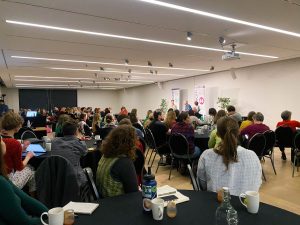How can you create captivating stories about the natural world?
What happens when you bring together hundreds of communications professionals with a passion for science and the natural world? Our Creative Projects Manager Sophie Jones went to this year’s Communicate Conference in Bristol to find out…
The Communicate Conference provides a forum to inspire, inform and support environmental communicators, and it’s gaining momentum. This year, for the first time, the event was delivered over three days in three different cities – Bristol, Manchester and London – with over one thousand people joining both in-person and online. The annual conference, hosted by the Natural History Consortium, has been running since 2004, long before stories of extinction were mainstream viewing, and is a must for anyone considering themselves an environmental communicator.
Embrace the responsibility
I’m one of the growing number of environmental communicators who are out there, shaping and sharing stories about nature. I’m mindful that scientists, and other communications professionals like me, are playing a significant role in growing public understanding of the natural world and what needs to be done to protect it. I’m aware it’s a big responsibility, given the vast challenges currently facing nature and, along with everyone who attended Communicate, I was there to lean into that responsibility. I enjoyed conversations with communications professionals from government, NGOs and businesses, all bringing their own specialisms – for me, it’s marine life and oceans – and all hungry for new learning, for opportunities to share insights and ideas, and to craft our storytelling to maximise our impact. I came away with inspiration, renewed enthusiasm and some communication top tips that I’d love to share.
The power of a good story
The keynote from Jonny Keeling, Head of the BBC Natural History Unit (NHU) shared how the NHU inspires a love for nature and a desire to protect it. With a global audience of over one billion people, you could say the NHU has got some experience to draw on! The room was hooked. Jonny encouraged us all to explore provocative questions: how can we entertain the public with negative headlines? How can we activate people to create real change? How can we reach new audiences?
In answering these questions Jonny helped us to understand the key components of a compelling story. Sharing examples from NHU flagship programmes, such as Planet Earth Three, he showed how the NHU is turning the global challenges facing nature into scientifically rigorous and original stories with emotional impact. His advice for cracking the code of compelling storytelling?
- Ground stories with science – tell the truth, but in an exciting, engaging way, with the focus on hope and inspiration, not on blame, guilt or fear.
- Be original – tell a unique story by creating something new or finding a new perspective on something known.
- Create an emotional impact – speak to your audience’s hearts and create resonance with their experiences. Keep people in the moment with powerful imagery and relatable characters, and tell stories of how people can come together to overcome challenges.
Jonny shared an NHU short about the right whale as a powerful example of all these storytelling ingredients successfully coming together. The right whale was hunted almost to extinction before an international whaling ban enabled numbers to return from the brink, and the NHU were able to use this story to tell a new and powerful tale of people successfully coming together to agree to protect nature.


Keep your audience in mind
Later in the day we also heard from Dimitri Houtart, the BBC Audio Rural Affairs, Food, Natural History & Environment Editor. Dimitri reminded us of how important it is to consider who you are trying to influence when shaping your story. Taking account of the audience’s lived experiences and priorities to tell a story that is compelling to them. He segmented environmental story audiences into three camps:
- Policymakers
- Supporters of environmental action
- ‘Fence sitters’ who are averse to change
He gave the example of how a compelling story supporting wind turbines would have a different focus (or spin), depending on the audience. Policy makers’ priorities would be linked to net zero targets and ‘supporters’ priorities would be reducing the use of fossil fuels and nuclear power, but ‘Fence sitters’ could be persuaded through a story that focuses on continuity with the past and emphasises the British traditions of technology and innovation, (along with the universally popular result that wallets would take a lesser hit with lower energy bills!)
Recharge yourself
Alongside the learning, I was delighted to find that the conference also created space for celebration and connection – to develop a regenerative culture within the industry, with recognition of the great work being done by environmental communicators and time to connect and recharge throughout the day – I loved learning from Kate Oliver about Radical Rest! Throughout the day the room was humming like a beehive. There were many presentations and panel discussions which sparked engaged and insightful conversations, from how to give nature a voice and representation in our legal systems, to farming to support biodiversity, to societal transformation to reduce our carbon footprint. No one was unaware of the work still to be done to protect the natural world, but Communicate’s unique buzz helped us all to enthusiastically lace up our boots for the long way yet to travel.
A selection of presentations from Communicate 2023 are now available to view online.
